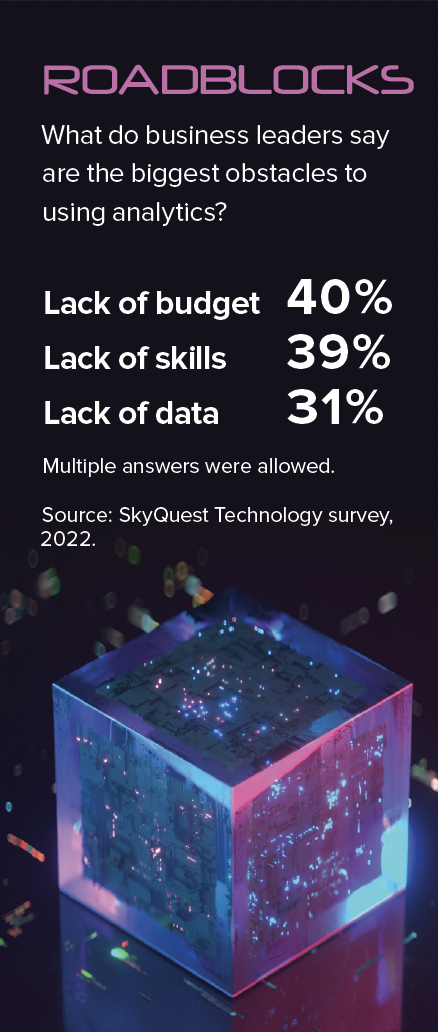
?Crystal balls might not exist, but that doesn’t mean companies don’t have the ability to gaze into the future. Hidden among hiring choices, performance reviews and employee engagement surveys are patterns that can help employers make strategic, evidence-based decisions about the future. The trick is knowing how and where to look.
Effectively engaging in predictive analytics—using past and present data to foretell future events—can help organizations make hiring decisions, anticipate skills shortages, head off employee attrition and react to the next major disruptive event.
All of that explains why the use of predictive analytics has grown by almost 50 percent in the last three years, according to a 2022 SkyQuest Technology survey. Business leaders who use workforce analytics say they have a better understanding of their talent needs than those who don’t, and they are more satisfied with their overall HR function.
Yet the survey also revealed that 42 percent of companies aren’t using workforce analytics at all. That can lead to missed opportunities and the continuation of wrong assumptions.
HR leaders at CUNA Mutual Group, an insurance company based in Madison, Wis., recently discovered just how valuable regular reviews of their company’s diversity, equity and inclusion (DE&I) metrics could be. While looking at their hiring processes, they came across an unexpected reason for why they weren’t drawing as many candidates of color as expected.
“The analytics helped us understand that we were seeing a different cycle between when a job was posted and when candidates of color were applying,” says Linda Nedelcoff, executive vice president and chief strategy and human resources officer for the 4,000-employee company. “They were generally applying later in the posting cycle.”
By reviewing the data, the HR team learned that they may have unintentionally been excluding some candidates of color by building job candidate lists too soon after posting a job opening. That introspection led them to ask hiring managers to make some immediate changes: post job openings to sites that attract more people of color, in addition to using general job boards; leave each posting up for a minimum of two weeks; and consider the entire candidate pool as a whole, no matter how each person discovered the job opening.
As a result, CUNA Mutual Group’s hiring rate for people of color now exceeds industry benchmarks, Nedelcoff says.
“Don’t be afraid to look back in your rearview mirror every once in a while,” she says. “The foundation is so important. If your foundation isn’t as strong as you think, you might build something unintentionally.”
Organizations of all sizes can benefit from studying their past and present data and using it to anticipate what the future may hold and how they should react to it. It’s important to note, though, that predictive analytics doesn’t simply mean perpetuating past patterns into the future.
“That’s only a good practice if you think your organization is perfect,” says Heather Whiteman, who specializes in people analytics as an assistant teaching professor at the University of Washington and has held HR executive roles. “If you think your organization is not quite where you hope it should be, then take every predictive analytics model under the assumption that this is what led to where we are and not where we want to be.”

Smarter Hiring
For many companies, hiring and growth are natural starting points for using predictive analytics, because these HR functions are considered critical to business strategy. In fact, 83 percent of talent leaders say hiring has escalated from an HR priority to a business-level priority, according to a 2022 Talent Acquisition Trends study by Lighthouse Research & Advisory, an Austin, Texas-based company that uncovers key trends and technologies in HR.
“Because of that elevation of HR leaders, they are in front of a brighter spotlight than ever before and they need to know what’s going on,” says Ben Eubanks, chief research officer for Lighthouse. “Predictive analytics can help them.”
It’s not enough for HR to simply know their headcounts. Instead, HR leaders are often expected to anticipate future skills needs and identify attrition concerns and solutions. In a modern workforce, that means organizations should make hiring decisions based on the skills needed not just for today’s employee, but also for tomorrow’s new recruit.
“Organizations should be hiring for capabilities, not just past performance,” Whiteman says.
She recommends considering qualities such as adaptability, creativity and interest in learning because these attributes could signal that a prospective employee—or an existing one—would be able to thrive in a changing environment. That’s key, considering half of global employees are expected to need to upskill or reskill by 2025 to perform new job duties and use new technologies, according to research from the World Economic Forum.
Traditionally, though, organizations have focused on hiring new employees based on their fit for the role at hand. And they do so largely by comparing candidates’ resumes and interviews, says Eubanks, author of Artificial Intelligence for HR: Use AI to Support and Develop a Successful Workforce (KoganPage, 2018).
Predictive analytics, however, can potentially provide much deeper insights by comparing a job candidate to a profile of an organization’s top employees. Companies can build a model of an “ideal” employee based on the skills, attributes and experience of employees who have thrived at the organization.
The idea isn’t to create a team of cut-and-paste copies, but rather to identify some of the traits that could allow employees to excel in a specific organization. Then recruiters can use this model, combined with technology such as applicant tracking systems, to help refine a list of job candidates.
In a tight labor market, that can make all the difference by shortening time-to-hire and finding candidates who are more likely to succeed and stay. However, organizations need to be careful to avoid perpetuating bias in their hiring and promotion practices, Whiteman says. For example, in the past, the majority of a company’s most successful managers may have predominantly come from a specific background. But that assumes that over the years, everyone has been given similar opportunities, which often isn’t the case, she explains.
She recommends that HR leaders use a simple technique to determine whether their approach is fair: Ask “why” five times to test hypotheses and help uncover the true reasons behind the results. Developed by Japanese industrialist Sakichi Toyoda, the “5 Whys” technique helps get to the root cause of a problem. If a deadline was missed, ask why. After the first answer, ask why again. Keep it up to get to the real problem.
Retaining Top Talent
Hiring an employee is, of course, only half the battle. The other key consideration is how to keep them. Employee retention is an area where companies can make good use of predictive analytics.
Data that most HR departments or organizations already track—employee engagement levels, time since last promotion, performance review ratings—can be plugged into predictive software to help identify factors that point to employees who are “flight risks.” Identifying why employees are likely to leave a company can help HR take measures designed to prevent them from leaving. In the long run, that can save companies money on hiring, training and lost productivity.
Making small changes to HR processes can help counter some common reasons employees are likely to leave a job. Take dissatisfaction with compensation and lack of interaction with their manager, for example. Eubanks recommends organizations look at tools they can introduce into the manager’s workflow to remind them to check in on their employees.  “Managers are busy. They’re pressed for time. And so you can use a tool that gives them a nudge,” he says.
“Managers are busy. They’re pressed for time. And so you can use a tool that gives them a nudge,” he says.
It might call out that they haven’t had a one-on-one with a team member in two months or that the person hasn’t had a pay change in two years and is now below the benchmark for the position, Eubanks explains.
A recent Gallup survey proves how powerful it can be to have managers regularly engage with their employees. While only 1 in 3 global employees strongly agree that someone has talked to them about their progress in the past six months, employees who receive meaningful feedback at least weekly are half as likely to be on the lookout for a new job, the survey results show.
Whiteman cautions that predictive attrition models should focus on larger groups, such as teams and departments, rather than solely on individuals. Singling out a specific employee as being at risk of leaving could turn that prediction into a self-fulfilling prophecy. A manager who believes John Doe is looking to leave the company might suddenly start treating John differently by, for example, withholding a promotion or not assigning him critical work. These factors could cause John to want to leave the company if he wasn’t already considering it.
“If it’s done at the individual level, it can harm the individual,” Whiteman says. “And what’s wrong with trying to preserve everyone on your team versus just one person?”
BATTLING BIAS
Many people believe that the best predictor of future behavior is past behavior.
But it can be a major mistake for HR leaders to assume that employee behavior can be explained and predicted based solely on what has happened before.
“The ethical piece is that if you’re making decisions about people and you’re using those data points, you have to understand what people are thinking and feeling,” says Ben Eubanks, chief research officer for Lighthouse Research & Advisory, based in Austin, Texas.
The best way to use predictive analytics is to marry data drawn from many sources with human insights, according to Michael Moon, director of people analytics at Viasat, a global communications company with 6,850 employees based in Carlsbad, Calif.
“You need to gather multiple sources of evidence and conscientiously and judiciously evaluate that evidence for its value and usefulness,” Moon says.
Otherwise, it can be too easy to perpetuate past biases into the future. Small sample sizes and poor handling of missing data can lead to high risk of bias in prediction models powered by machine learning, research shows.
Such could be the case when organizations decide whom to promote, says Heather Whiteman, who focuses on people analytics as an assistant teaching professor at the University of Washington. Many organizations rely heavily on performance reviews and feedback from an employee’s manager, yet that person may not always be the best equipped to assess the individual’s performance, Whiteman says.
That’s why she recommends that companies conduct an organizational network analysis to “learn who works with whom and have those people weigh in on performance.”
Companies also should have specific policies about how they use and protect the data they collect on employees. For example, Moon says, if an organization uses employee monitoring software to assign employees productivity scores, HR should track the data but should not tell employees—and perhaps not even their managers—the scores. That’s because true productivity can’t be measured solely based on how long employees spend on “provable” work, and reliance on such scores can wind up stigmatizing or demoralizing employees rather than motivating them to work harder.
And while some employees may appreciate data-driven insights about themselves, others may find the revelations intrusive. Whiteman recommends that HR professionals take a “don’t be creepy” approach to deciding how to use the data they’ve collected.
“If you ask yourself, ‘Is it creepy?’ and you pause at all, don’t use it,” she says. —K.R.
Where to Focus
Despite strong buy-in from business leaders, only 20 percent of organizations are using analytics extensively, the SkyQuest survey found. The main obstacles cited are a lack of funds, a lack of skills and a lack of data.
These struggles can be experienced by companies both large and small. Larger companies may feel overwhelmed by too much data, while smaller ones may not have enough data from which to draw useful conclusions. For example, looking at historic data on why female managers leave a company may not be particularly useful for companies that have had only a few female managers. But there are steps HR can take to address these issues.
For companies that might not have the money to hire analytics experts or purchase new software, Nedelcoff recommends checking in with other departments in the company or with contacts in professional organizations who have had success using analytics. For CUNA Mutual Group’s HR department, that meant adopting technology being used by another department for HR’s purposes.
“Our options were: We could go out and buy and build the perfect tool, or we could [use an existing company tool] and customize it for our own purpose,” Nedelcoff says. “We decided to leverage existing company tech resources even though they were originally designed for customer solutions.”
As a bonus, the work of vetting the software had already been done.
It can also be useful to focus on using predictive analytics in a few key areas, instead of trying to make forecasts for multiple areas all at once.
“Think about your most important strategic initiatives. During the pandemic and Great Resignation periods, hiring analytics have been really important,” Nedelcoff says. “Rather than wide breadth, our company focuses on the most critical and then focuses on the next critical. But if you have larger capability and capacity, you might focus on three to four streams.”
CUNA Mutual Group chose to focus on using predictive analytics for planning DE&I efforts throughout the company.
The company also relies on analytics to evaluate and customize how it trains managers. HR leaders combine behavioral science principles with behavioral analytics for individual managers to determine which managers would appreciate what types of training at what stages of their careers.
“Often, we give managers a lot of training when they’re new, and much of it won’t be applied until a certain moment in their career,” Nedelcoff says. “What if we offer training when it’s most needed instead? Maybe that feature becomes more useful at the three-month mark, not day one. By studying scientifically, you can learn to cater those resources to be much more beneficial for that period of time.”
Above all, people analytics experts agree that it’s important for businesses not to forget the human element when making predictions about the future.
“Because these are people’s lives and their livelihoods,” Whiteman says, “everything needs to be for people, not just about people.”
Kate Rockwood is a freelance writer based in Chicago.
Images by gonin / shutterstock.

